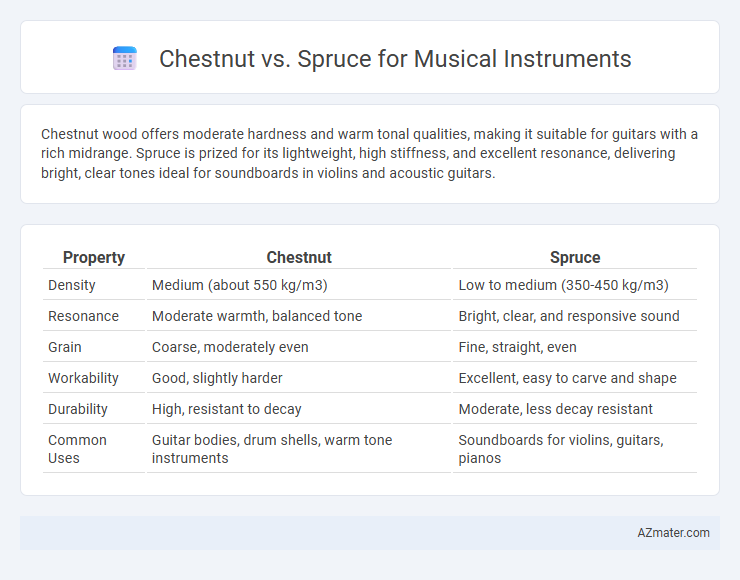Chestnut wood offers moderate hardness and warm tonal qualities, making it suitable for guitars with a rich midrange. Spruce is prized for its lightweight, high stiffness, and excellent resonance, delivering bright, clear tones ideal for soundboards in violins and acoustic guitars.
Table of Comparison
| Property | Chestnut | Spruce |
|---|---|---|
| Density | Medium (about 550 kg/m3) | Low to medium (350-450 kg/m3) |
| Resonance | Moderate warmth, balanced tone | Bright, clear, and responsive sound |
| Grain | Coarse, moderately even | Fine, straight, even |
| Workability | Good, slightly harder | Excellent, easy to carve and shape |
| Durability | High, resistant to decay | Moderate, less decay resistant |
| Common Uses | Guitar bodies, drum shells, warm tone instruments | Soundboards for violins, guitars, pianos |
Overview: Chestnut vs Spruce in Instrument Making
Chestnut and spruce are both highly regarded woods in musical instrument making, valued for their tonal qualities and workability. Spruce, especially Sitka spruce, is renowned for its excellent strength-to-weight ratio, providing bright, resonant tones and robust projection, making it the preferred choice for guitar and violin soundboards. Chestnut offers a warmer, richer sound with good sustain, often used in traditional and folk instruments, but it is less common than spruce due to its heavier density and differing resonance characteristics.
Physical Properties: Density and Grain Structure
Chestnut wood exhibits a density typically around 500-600 kg/m3, providing a moderate weight that offers good resonance with a slightly porous grain structure favorable for warm tonal qualities in musical instruments. Spruce, with a lower density ranging from 350-450 kg/m3, is prized for its tight, straight grain and stiffness-to-weight ratio, enhancing sound projection and clarity in instruments like guitars and violins. The grain structure of spruce allows for superior vibration transmission, making it ideal for soundboards, while chestnut's coarser grain offers a richer, mellower tone suitable for back and sides.
Acoustic Performance: Sound Quality Comparison
Chestnut wood produces a warm, rich tone with pronounced midrange frequencies, making it ideal for guitars and violins aiming for a mellow, balanced sound. Spruce, known for its high stiffness-to-weight ratio, delivers a bright, clear, and resonant sound with excellent projection and dynamic range, favored in classical and acoustic guitars for articulate high-end response. The choice between chestnut and spruce significantly impacts the instrument's tonal character, with chestnut offering warmth and fullness, while spruce provides clarity and volume.
Durability and Longevity in Musical Use
Chestnut wood offers moderate durability and a warm tonal quality, but it tends to be less dense and more prone to wear compared to spruce. Spruce, especially Sitka or Engelmann varieties, is highly favored for its exceptional strength-to-weight ratio and superior resonance, ensuring longevity even under rigorous playing conditions. Musicians often choose spruce for soundboards due to its consistent stiffness and resilience, enhancing the instrument's durability and sustained tonal clarity over time.
Workability for Luthiers and Craftsmanship
Chestnut wood offers moderate workability with a fine, straight grain that allows luthiers to shape and carve detailed instrument parts with relative ease, though it is slightly softer and less stable than traditional tonewoods. Spruce is highly favored for luthiers due to its excellent strength-to-weight ratio, straight grain, and superior responsiveness, making it ideal for soundboards that require precise craftsmanship and optimal acoustic performance. While chestnut provides a unique aesthetic and warm tonal qualities, spruce remains the benchmark for workability and reliability in professional instrument making.
Availability and Sustainability
Chestnut is less commonly used than spruce in musical instrument making, resulting in limited availability and higher costs. Spruce, especially Sitka and Engelmann varieties, remains the preferred choice due to its widespread availability and proven acoustic qualities. Sustainability efforts favor sustainably harvested spruce forests, while chestnut sourcing faces challenges from reduced old-growth populations and stricter logging regulations.
Traditional Usage in Instrument History
Chestnut wood has been traditionally favored for its lightness and resonance in crafting stringed instruments like lutes and early violins, providing warm tonal qualities suited for baroque music. Spruce, with its superior strength-to-weight ratio and consistent grain, dominates as the preferred soundboard material in classical guitars and grand pianos, enhancing clarity and projection. The historic use of chestnut often reflects regional availability and tonal preference, while spruce's widespread adoption stems from its acoustic stability and responsiveness across diverse musical styles.
Cost Analysis: Chestnut vs Spruce
Chestnut generally offers a more cost-effective option compared to spruce for musical instrument construction, with prices often 20-30% lower due to its relative abundance and faster growth rates. Spruce, particularly Sitka or Engelmann varieties, commands a premium price owing to its superior tonal qualities, lightweight strength, and historical use in high-end instruments. The choice between chestnut and spruce hinges on budget constraints versus desired acoustic performance, with spruce favored for professional-grade instruments despite its higher cost.
Aesthetic Differences and Visual Appeal
Chestnut wood exhibits a warm, rich grain with pronounced growth rings and a golden-brown hue, offering a vintage, rustic aesthetic ideal for traditional musical instruments. Spruce presents a lighter, pale cream to yellow color with a fine, straight grain pattern, providing a clean, elegant look favored for modern acoustic instruments. The contrasting textures and colors between chestnut's bold character and spruce's subtle uniformity significantly influence the visual appeal and style of guitars, violins, and other string instruments.
Best Applications: Instrument Types for Each Wood
Chestnut is ideal for crafting classical guitars and violins, offering warm tonal qualities and moderate resonance that enhance string vibrations. Spruce is preferred for acoustic guitar soundboards, violin tops, and ukuleles due to its superior stiffness-to-weight ratio, producing bright, clear, and responsive sound. The best application of chestnut lies in instruments requiring a softer, mellower tone, while spruce excels in instruments demanding projection and dynamic sensitivity.

Infographic: Chestnut vs Spruce for Musical Instrument
 azmater.com
azmater.com